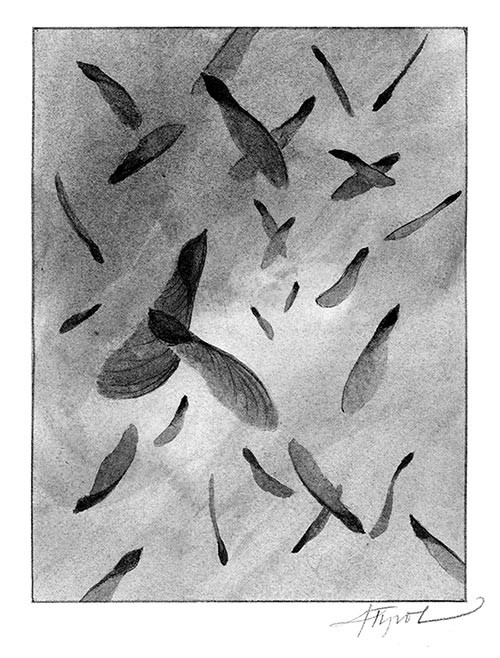
Helicopters. Keys. Whirligigs. Samaras. Whatever you call the winged seeds released by maple trees, here’s one more word for them: delicious.
Like many New Englanders, I have fond childhood memories of dropping maple “helicopters” from a height and watching them twist and twirl down to the ground. My children do the same now. They gather fistfuls of maple samaras, toss them over the railing of the upstairs porch, and watch them flutter earthward.
Maybe I should tell them to stop playing with their food. Turns out those seeds are edible, packed with protein and carbohydrates, and quite tasty. Before the tended garden plot has yielded even one peapod or lettuce leaf, red and silver maple samaras offer a spring delicacy for opportunistic backyard foragers. A second crop of samaras, from species including sugar maples, striped maples and boxelders, will ripen and fall in early autumn. All maple species native to the Northeast have edible seeds.
Maple samaras come in twos, with their seed pods fused together and the wings spreading from either side – a bit like a handlebar mustache. The size and color of the wings and the angle at which they connect will vary among individual samaras but are helpful indications of tree species. Red maple samaras have reddish wings about one inch long and linked at a 60-degree angle. Sugar maples attach at a similar angle, but the wings are slightly larger (about 1 ¼ inch) and greener. Striped (moose) maples have wider wings, joined at a 140-degree angle. Silver maple samaras are considerably larger – about two inches long – and connected at a 90-degree angle.
These seeds are built for travel. Dispersed by the wind, maple samaras take advantage of their helicopter attributes by spinning distances as far as 330 feet. Falling samaras may reach a terminal velocity of three meters per second (about three miles per hour). The distance and speed of travel depends partly on the surrounding cover; samaras dropped by trees in open fields or yards are likely to spin farther than those dropped by maples in dense woods. Trees tend to release seeds when they’re already partially dried out, and while these are edible, those samara plucked right from the tree are generally tastier.
Getting to the maple seed is a bit like shelling garden peas; you have to peel off the outer casing to reveal the fruit within. And there’s no one way to eat a maple seed. Some people like to pop them into their mouths plain. Others steam or boil them and add butter and salt or favorite spices. Maple seeds can also be roasted, added to salads and other dishes, or dried and ground into flour.
Some people find maple seeds slightly bitter, however Linda Runyon, author of several books about foraging wild foods, described them as sweet, with a “mild maple taste.” The taste and level of tartness can vary from tree to tree and between species, and bitter seeds can be boiled to leach the sharpness.
Runyon’s favorite way to enjoy the seeds is to make maple patties. She gathers about two cups of samaras and selects the mid-sized ones for shelling: “They’re the tastiest. The big ones are starting to dry out, and the little ones are not quite ready.” After mashing the shelled seeds into a squishy pulp, she forms small patties. These can be fried in oil and served with the maple tree’s other natural wonder – maple syrup.
The red maples around our yard are laden with tiny samaras. We’re keeping an eye on them, checking every couple of days to see if the seeds are big enough to collect for eating. My kids have never been so excited to try a new food. And there should be plenty of leftover helicopters to toss into the wind and watch as they spin.


Discussion *